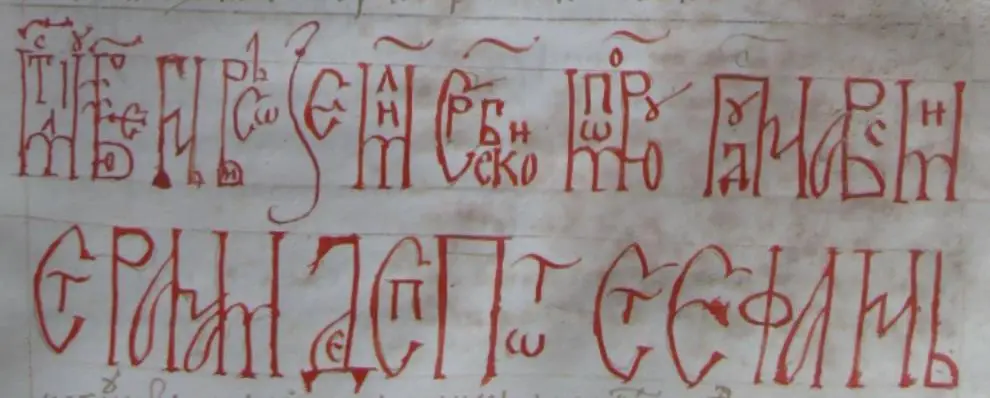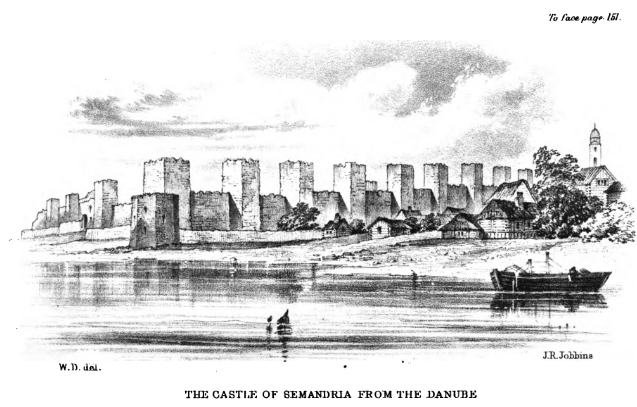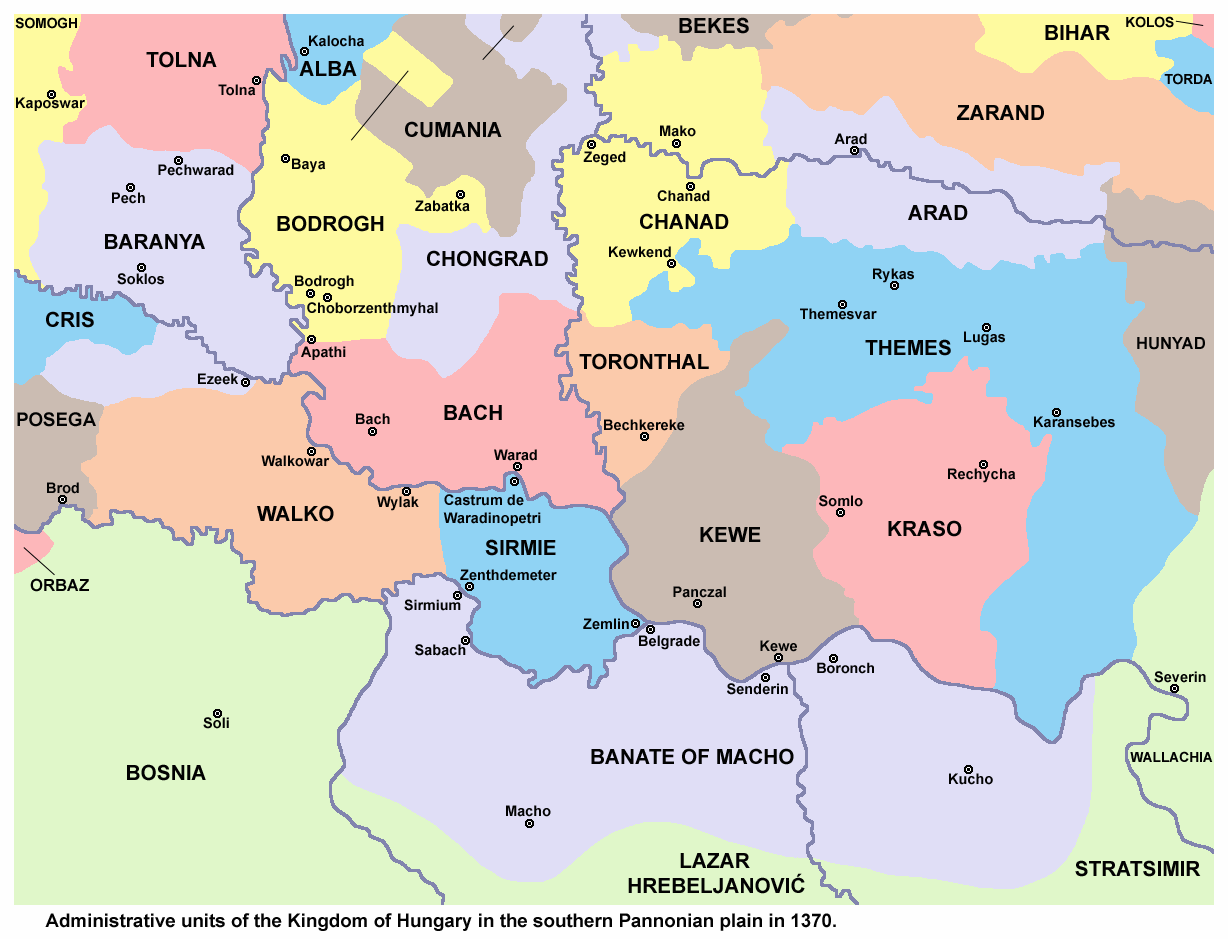SERVIA,
YOUNGEST MEMBER OF THE EUROPEAN FAMILY:
OR, A
RESIDENCE IN BELGRADE,
AND
TRAVELS IN THE HIGHLANDS AND WOODLANDS OF THE INTERIOR,
DURING THE YEARS 1843 AND 1844.
BY
ANDREW ARCHIBALD PATON, ESQ.
CHAPTER XVII.
Coronation Church of the ancient Kings of Servia.—Enter the Highlands.—Valley of the Ybar.—First view of the High Balkan.—Convent of Studenitza.—Byzantine Architecture.—Phlegmatic Monk.—Servian Frontier.—New Quarantine.—Russian Major.
We again started after mid-day, with the captain and his momkes, and, proceeding through meadows, arrived at Zhitchka Jicha. This is an ancient Servian convent, of Byzantine architecture, where seven kings of Servia were crowned, a door being broken into the wall for the entrance of each sovereign, and built up again on his departure. It is situated on a rising ground, just where the river Ybar enters the plain of Karanovatz. The environs are beautiful. The hills are of moderate height, covered with verdure and foliage; only campaniles were wanting to the illusion of my being in Italy, somewhere about Verona or Vicenza, where the last picturesque undulations of the Alps meet the bountiful alluvia of the Po. Quitting the valley of the Morava, we struck southwards into the highlands. Here the scene changed; the valley of the Ybar became narrow, the vegetation scanty; and, at evening, we arrived at a tent made of thick matted branches of trees, which had been strewn for us with fresh hay. The elders of Magletch, a hamlet an hour off, came with an offer of their services, in case they were wanted.
The sun set; and a bright crackling fire of withered branches of pine, mingling its light with the rays of the moon in the clear chill of a September evening, threw a wild and unworldly pallor over the sterile scene of our bivouac, and the uncouth figures of the elders. They offered me a supper; but contenting myself with a roasted head of Indian corn, and rolling my cloak and pea jacket about me, I fell asleep: but felt so cold that, at two o’clock, I roused the encampment, sounded to horse, and, in a few minutes, was again mounting the steep paths that lead to Studenitza.
Day gradually dawned, and the scene became wilder and wilder; not a chalet was to be seen, for the ruined castle of Magletch on its lone crag, betokened nothing of humanity. Tall cedars replaced the oak and the beech, the scanty herbage was covered with hoar-frost. The clear brooks murmured chillingly down the unshaded gullies, and a grand line of sterile peaks to the South, showed me that I was approaching the backbone of the Balkan. All on a sadden I found the path overlooking a valley, with a few cocks of hay on a narrow meadow; and another turn of the road showed me the lines of a Byzantine edifice with a graceful dome, sheltered in a wood from the chilling winter blasts of this highland region. Descending, and crossing the stream, we now proceeded up to the eminence on which the convent was placed, and I perceived thick walls and stout turrets, which bade a sturdy defiance to all hostile intentions, except such as might be supported by artillery.
On dismounting and entering the wicket, I found myself in an extensive court, one side of which was formed by a newly built crescent-shaped cloister; the other by a line of irregular out-houses with wooden stairs, chardacks and other picturesque but fragile appendages of Turkish domestic architecture.
Between these pigeon-holes and the new substantial, but mean-looking cloister, on the other side rose the church of polished white marble, a splendid specimen of pure Byzantine architecture, if I dare apply such an adjective to that fantastic middle manner, which succeeded to the style of the fourth century, and was subsequently re-cast by Christians and Moslems into what are called the Gothic and Saracenic.1
A fat, feeble-voiced, lymphatic-faced Superior, leaning on a long staff, received us; but the conversation was all on one side, for “Blagodarim,” (I thank you,) was all that I could get out of him. After reposing a little in the parlour, I came out to view the church again, and expressed my pleasure at seeing so fair an edifice in the midst of such a wilderness.
The Superior slowly raised his eyebrows, looked first at the church, then at me, and relapsed into a frowning interrogative stupor; at last, suddenly rekindling as if he had comprehended my meaning, added “Blagodarim” (I thank you). A shrewd young man, from a village a few miles off, now came forward just as the Superior’s courage pricked him on to ask if there were any convents in my country; “Very few,” said I.
“But there are,” said the young pert Servian, “a great many schools and colleges where useful sciences are taught to the young, and hospitals, where active physicians cure diseases.”
This was meant as a cut to the reverend Farniente. He looked blank, but evidently wanted the boldness and ingenuity to frame an answer to this redoubtable innovator. At last he gaped at me to help him out of the dilemma.
“I should be sorry,” said I, “if any thing were to happen to this convent. It is a most interesting and beautiful monument of the ancient kingdom of Servia; I hope it will be preserved and honourably kept up to a late period.”
“Blagodarim, (I am obliged to you,)” said the Superior, pleased at the Gordian knot being loosed, and then relapsed into his atrophy, without moving a muscle of his countenance.
I now examined the church; the details of the architecture showed that it had suffered severely from the Turks. The curiously twisted pillars of the outer door were sadly chipped, while noseless angels, and fearfully mutilated lions guarded the inner portal. Passing through a vestibule, we saw the remains of the font, which must have been magnificent; and covered with a cupola, the stumps of the white marble columns which support it are still visible; high on the wall is a piece of sculpture, supposed to represent St. George.
Entering the church, I saw on the right the tomb of St. Simeon, the sainted king of Servia; beside it hung his banner with the half-moon on it, the insignium of the South Slavonic nation from the dawn of heraldry. Near the altar was the body of his son, St. Stephen, the patron saint of Servia.2 Those who accompanied us paid little attention to the architecture of the church, but burst into raptures at the sight of the carved wood of the screen, which had been most minutely and elaborately cut by Tsinsars, (as the Macedonian Latins are called to this day).
Close to the church is a chapel with the following inscription:
“I, Stephen Urosh,3 servant of God, great grandson of Saint Simeon and son of the great king Urosh,4 king of all the Servian lands and coasts, built this temple in honour of the holy and just Joachim and Anna, 1314. Whoever destroys this temple of Christ be accursed of God and of me a sinner.”
Thirty-five churches in this district, mostly in ruins, attest the piety of the Neman dynasty.5 The convent of Studenitza was built towards the end of the twelfth century, by the first of the dynasty. The old cloister of the convent was burnt down by the Turks. The new cloister was built in 1839. In fact it is a wonder that so fine a monument as the church should have been preserved at all.
There is a total want of arable land in this part of Servia, and the pasture is neither good nor abundant; but the Ybar is the most celebrated of all the streams of Servia for large quantities of trout.
Next day we continued our route direct South, through scenery of the same rugged and sterile description as that we had passed on the way hither. How different from the velvet verdure and woodland music of the Gutchevo and the Drina! At one place on the bank of the Ybar, there was room for only a led horse, by a passage cut in the rock. This place bears the name of Demir Kapu, or Iron Gate. In the evening we arrived at the frontier quarantine, called Raska, which is situated at two hours’ distance from Novibazar.
In the midst of an amphitheatre of hills destitute of vegetation, which appeared low from the valley, although they must have been high enough above the level of the sea, was such a busy scene as one may find in the back settlements of Eastern Russia. Within an extensive inclosure of high palings was a heterogeneous mass of new buildings, some unfinished, and resounding with the saw, the plane, and the hatchet; others in possession of the employés in their uniforms; others again devoted to the safe keeping of the well-armed caravans, which bring their cordovans, oils, and cottons, from Saloniki,6 through Macedonia, and over the Balkan, to the gates of Belgrade.
On dismounting, the Director, a thin elderly man, with a modest and pleasing manner, told me in German that he was a native of the Austrian side of the Save, and had been attached to the quarantine at Semlin; that he had joined the quarantine service, with the permission of his government, and after having directed various other establishments, was now occupied in organizing this new point.
The traiteur of the quarantine gave us for dinner a very fair pillaff, as well as roast and boiled fowl; and going outside to our bench, in front of the finished buildings, I began to smoke. A slightly built and rather genteel-looking man, with a braided surtout, and a piece of ribbon at his button-hole, was sitting on the step of the next door, and wished me good evening in German. I asked him who he was, and he told me that he was a Pole, and had been a major in the Russian service, but was compelled to quit it in consequence of a duel.
I asked him if he was content with his present condition; and he answered, “Indeed, I am not; I am perfectly miserable, and sometimes think of returning to Russia, coûte qui coûte.—My salary is £20 sterling a year, and everything is dear here; for there is no village, but an artificial settlement; and I have neither books nor European society. I can hold out pretty well now, for the weather is fine; but I assure you that in winter, when the snow is on the ground, it exhausts my patience.” We now took a turn down the inclosure to his house, which was the ground-floor of the guard-house. Here was a bed on wooden boards, a single chair and table, without any other furniture.
The Director, obliging me, made up a bed for me in his own house, since the only resource at the traiteur’s would have been my own carpet and pillow.
- Ingenious treaties have been written on the origin of the Gothic and Saracenic styles of architecture; but it seems to me impossible to contemplate many Byzantine edifices without feeling persuaded that this manner is the parent of both. Taking the Lower Empire for the point of departure, the Christian style spread north to the Baltic and westwards to the Atlantic. Saint Stephen’s in Vienna, standing half way between Byzantium and Wisby, has a Byzantine façade and a Gothic tower. The Saracenic style followed the Moslem conquests round by the southern coasts of the Mediterranean to Morocco and Andaloss. Thus both the northern and the eastern styles met each other, first in Sicily and then in Spain, both having started from Constantinople. ↩︎
- Tran. note: Mr Paton has his information slightly wrong here, as St Stefan (Stephen) was the first crowned King of Serbia, while St Simeon (lay name Stefan Nemanja) held the rank of Veliki Župan (Grand Župan), a rank below royal status. ↩︎
- Tran. note: King Stefan Uroš II Milutin. ↩︎
- Tran. note: King Stefan Uroš I, also Uroš the Great. ↩︎
- Tran. note: Nemanjić dynasty, literally “descendants of Nemanja”, after Stefan Nemanja. ↩︎
- Tran. note: Thessaloniki in Greece. ↩︎



